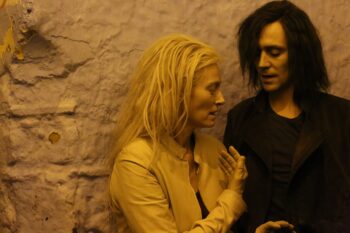
There is something sexy about the type of languid decay we see throughout Only Lovers Left Alive, the latest Jim Jarmusch film that is more about intimacy than vampires. Vampires have always been the sexiest of demon creatures, precisely because the bonds that connect them trigger every fear we have of connecting with another person—of bodily fluids and contamination, of physical bonding, of either perishing or being irreparably transformed.
Only Lovers Left Alive distinguishes itself from other vampire stories in that it focuses not only on the dangers of an all-consuming love, but on the pleasures of this type of bond as well. In 2014, vampire stories hold an odd place in the American imagination, when the risks of contamination and the ubiquity of hook-up culture exist simultaneously. The most famous vampire tale of the past several years is Twilight, a series that has been un-affectionately dubbed by critics as “abstinence porn.” Feminist critics, myself included, often point out the tremendous problem with defining girls and young women by whether or not they are sexually active. We argue that sex often doesn’t bond us to each other, or change who we are—that sometimes sex is just sex, and as long as we use appropriate protection it really doesn’t matter if or when or how we do it.
In this way vampire stories challenge the modern audience to see sex as something primitive and powerful, something with the potential to open you, to gut you, to wake you up, to feed and nourish you, to annihilate you, to set the heart on fire, to make you feel incredibly powerful and gloriously weak.
In Twilight the imbalance of power is cut clearly across gender lines, but in Only Lovers Left Alive, the union between Adam and Eve is tender and egalitarian. When we first meet the vampire couple, Adam (Tom Hiddleston) is living in a dilapidated house on the outskirts of Detroit, where he spends his days recording music with beautiful old instruments, each with its own gorgeous and intricate history. Eve (Tilda Swinton) is living in Tangier, in an apartment heavy with books and poetry. Though they communicate often, they are living in separate places, until Eve decides to come visit Adam when she senses how melancholy he has become in recent months. Both value artifacts from the past, but Eve is more practical. In one scene, for example, after a series of unfortunate events, Adam and Eve need to quickly leave Adam’s home in Detroit. While Adam is reluctant to leave his guitars, Eve reminds him that the world is filled with beautiful instruments.
The lush backdrops of Detroit and Tangier are lit by moonlight. Most of the film plays out in the private worlds of Adam and Eve, who create an enchanting world all of their own as densely evocative music plays behind thick curtains. The love that Adam and Eve share is incredibly gentle. The two have been married for centuries, but when Eve visits she still waits for Adam to ceremoniously invite her inside and to remove her gloves. Except for one scene where we see their naked bodies tenderly entwined in bed, we view their connection as emotional and intellectual. The two play chess while eating type-O blood popsicles, and when Eve packs to visit Adam all she takes are books upon books upon books.
In Only Lovers Left Alive, love is depicted as eternal, but the world itself is shown to be in constant flux. The deterioration of the world around them often seems to trouble Adam more than it troubles Eve. When Adam says that all the sands of the hourglass feel as though they have shifted to the bottom, Eve encourages him to turn the hourglass over. In a similar way, when Adam and Eve talk about the abandoned buildings of Detroit, Eve is confident that the city will rise again.
Music is the connective tissue that ignites passion and unites these lovers, forming a visceral bridge between cultures—vampire and human, Moroccan and American. Adam and Eve’s reverence for culture makes them somewhat empathetic to humanity, though they often decry the “zombies,” or humans, who they see as destroying the world through resisting humane ideas and scientific knowledge, as well as by going to war and polluting the world. Adam and Eve are condemned to a life on the periphery, appreciating the world as careful observers. When Adam fears he has nothing left to live for, Eve offers suggestions—to spend less time moping and more time appreciating nature, to find ways to be kind to one another, dancing.
Throughout the film Adam and Eve find blood suppliers, ensuring their supply is pure and untainted, as well as removing the “medieval” necessity of ever having to take a life. In the end, though, Jarmusch shows how even these polite and gentle, if moody creatures, have something akin to bloodlust. Despite all their philosophizing about what it means to feed off a couple they see locked in a passionate embrace, the world is reduced to what it always was—a beautiful and surreal symphony of blood and teeth.




